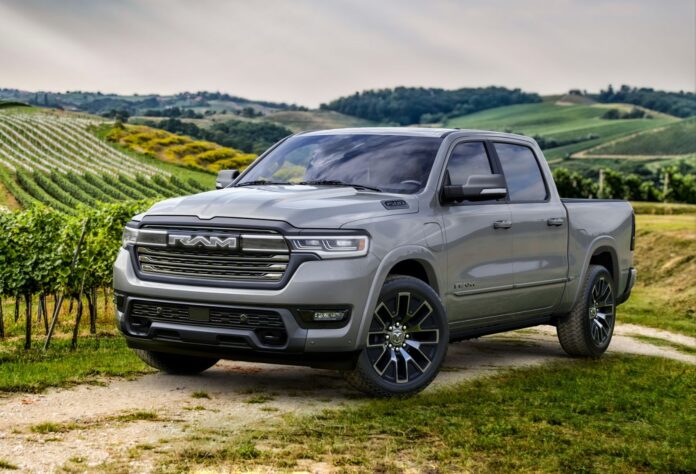Ram CEO Tim Kuniskis has questions about today’s electric vehicle market, and skepticism about what customers really want.
Automakers aren’t tasked with just selling vehicles on dealer lots today. They must predict the future, developing products that they anticipate the public will want a decade from now. Ram, a brand under the Stellantis umbrella, is no exception.
Traditionally, for most companies, this means starting work on a new model six to seven years before it comes to market. By the time a new vehicle launches, changes to it two to three years down the road are already well underway in the research and development department.
We are at the dawn of the electrification age of modern automobiles. Every automaker is trying to find the right play for their market, while spending billions of dollars on developing electric vehicle technology.
For all the EV hype, the ramp up to widespread battery-electric vehicle sales in the U.S. has not been as quick as many predicted it would be. In survey after survey, customers cite charging infrastructure, range and vehicle purchase costs among the largest obstacles to adoption.
“We can expect the crop of electric trucks to grow in size as newcomers arrive from Ram, Toyota and others…but it’s going to be a very tough sell because when we look at both consideration and intention to buy a pickup truck amongst EV shoppers, those numbers are pretty low,” Robby DeGraff, manager of product and consumer insights at AutoPacific, told Newsweek.
“More than 60 percent of large pickup truck and 55 percent of midsize pickup truck intenders want internal combustion engine propulsion. Intention amongst all EV buyers who do actually want a pickup truck of any size is very low; however, those shopping in the midsize segment (Tacoma, Frontier, Colorado, etc.) are a bit more eager to actually purchase one that’s battery powered. Consideration for battery-electric propulsion is stronger amongst midsize pickup truck buyers too,” he said.
The U.S. government has not been as heavy handed with regulatory measures as countries in Asia and Europe, where low-emissions zones, and associated fees and fines, are commonplace. In those areas, regulation is driving EV adoption, among other factors.
“We’ve invested over half a trillion dollars in our transition to electrification. In today’s dollars, that’s more than double what we spent to get to the moon. It’s insane, right?” Tim Kuniskis, CEO of Ram, told Newsweek during a media briefing.
“But we had to do it. We had to do it because we had to design, engineer, build, break (into) the market and sell. The last most important part, sell electric vehicles. Because we needed to comply, right? We needed to comply with the regulations,” he said.
Kuniskis has questions: “But what regulations? I don’t know. It’s impossible to tell. The regulatory landscape is like three-dimensional chess. How do you know what to do and where the next smart play is going to be. It’s like three-dimensional chess, but every one of the players, every one of the pieces, is a king who’s actually calling the shots. Is it the administration? Is it the regulators? Is it the dealers? Is it NGOs? Is it the customer? I mean, that’s what it used to be. Is that how it is supposed to be? I don’t know.”
In January, U.S. Department of Transportation Secretary Sean Duffy released a memo outlining the Trump administration’s objectives for corporate average fuel economy (CAFE) standards. Those standards have traditionally been seen as emissions goalposts for automakers, and there are fines for noncompliance.
The memo, in part, reads:
“These fuel economy standards are set at such aggressive levels that automakers cannot, as a practical matter, satisfy the standards without rapidly shifting production away from internal-combustion engine (ICE) vehicles to alternative electric technologies.…
“Fuel economy standards that diminish the strength of America’s auto industry and deny Americans the full range of affordable ICE vehicles they need and are willing to pay for cannot satisfy the ‘technological feasibility’ and ‘economic practicability’ requirements of the governing law. The purpose of the CAFE program is not to force the electrification of the Nation’s auto fleets; it is to establish the maximum average fuel economy standards that are realistic and feasible for fleets of vehicles of all sizes and uses that run on combustible liquid fuels like gasoline and diesel fuel and that the auto industry is capable of producing and selling in sufficient volume to meet the real-world market demand of American buyers.”
When contacted for comment and an update on the CAFE program, a Department of Transportation spokesperson pointed Newsweek back to the memo.
Since regaining his post at the head office of Ram in late 2024, Kuniskis has had to make tough calls regarding the future of two previously announced trucks, the Ram 1500 Ramcharger and Ram 1500 Rev.
The Ramcharger is a hybrid model that uses a gasoline-powered V6 engine connected to a generator to charge its large electric battery when the battery runs out. It is expected to be able to go 690 miles, under ideal conditions, before running out of fuel.
Ram’s 1500 Rev is a battery-electric truck, fueled only by electrons, that is set to rival Ford’s F-150 Lightning and the Chevrolet Silverado EV out of the gate.
The Ramcharger is now expected to arrive in market later this year. Ram’s 1500 Rev pickup has been pushed to late 2026.
Kuniskis said: “There is one thing in that three-dimensional chess game that’s very important. Nothing else matters but the product. If you get the product right, it’s not that nothing else matters, but everything else gets a lot easier if you get the product right. The half-a-trillion-dollar question is: What is the right product?”
With changing tides, including economic uncertainty tied to world markets reacting to U.S. tariffs, the answers to Kuniskis’ questions might not reveal themselves for years.
“You have all these challenges, cost, charger capability and range cost. If I look at an internal combustion engine (vehicle) versus a full battery-electric, it’s going to be more expensive, which is going to put pressure on pricing,” Kuniskis said.
He has more questions: “I look at charging. How do I charge it? How long does it take to charge? Do I have the infrastructure where I live, where I work? Do I have that equation solved?
“Capability? You can do all those things, but does it have the capability that a truck buyer actually needs for work and for play? Can it do truck things?
“What’s the range going to be? Is it the standard range, or what’s the range really going to be depending on the weather, my driving style, if I’m towing or not?”
Kuniskis recognizes the interdependencies of each question in play. “(It is a) very complicated web of things, and the most important one is cost, because this is the one everybody’s talking about. This is the one that’s driving the industry today.”
The largest factor in the cost of internal combustion engine powertrains versus hybrid or battery-electric is the cost of the battery. Experts predict that the cost of a battery will decrease as they are produced at larger scale.
Kuniskis spelled out what this means for Ram customers, without divulging how much the company actually pays for its battery cells: “Rev was a 229-kilowatt hour battery.… Let’s pick 100 (dollars per kilowatt hour) just to make the math easy. Two hundred twenty-nine kilowatt hours is a $23,000 battery.…The standard range Rev (has a )168-kilowatt hour battery. That’s a $17,000 battery.”
Regarding Ramcharger, he said: “Ramcharger only has a 92-kilowatt-hour (battery). From day one, the cost basis is going to be anywhere from eight to $14,000 less than those other options, and that’s at $100—if you’re over $100, the cost basis is even better.”
Ram has the goal of paying just $50 per kilowatt hour but hasn’t been able to get there yet. He said “some people say” that they are paying less than $100 per kilowatt hour in today’s market.
Battery costs could be passed onto the customer, with the truck selling for thousands more than an internal combustion-engined model or hybrid truck. If it is not passed onto the customer, it is likely that the company would lose money with every truck it sells.
The average retail transaction price in the U.S. for a new full-size truck from any automaker was $57,400 in January and $55,900 in February, J.D. Power told Newsweek. This is close to what was paid during the same months in 2024.


